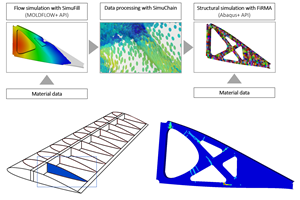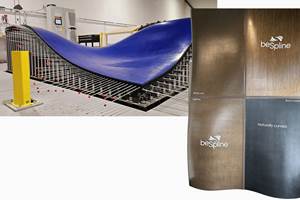Glass transition temperature testing of composites
The glass transition temperature of polymer matrix composites (PMCs) is determined by a series of tests at increasing temperatures.
Polymer matrix composites (PMCs) exhibit impressive stiffness and strength properties that are commonly attributed to the reinforcing fibers. However, for many important mechanical properties, the polymer matrix also plays an important role. For example, the fiber direction compression strength of a PMC is highly dependent on the polymer matrix material’s ability to support the reinforcing fibers and resist buckling under compression loading.
The role of the polymer matrix material becomes apparent when evaluating “matrix-dominated” mechanical properties of PMCs at elevated temperature conditions, at which the stiffness and strength properties of the polymer matrix are reduced. These mechanical properties gradually decrease as the test temperature increases, due to reductions in the polymer matrix material properties. As the temperature of thermosetting PMCs are further increased, the polymer matrix material undergoes a transition from the glassy state present at lower temperatures to a more rubbery state. The thermosetting polymer does not melt, but a two to three order of magnitude reduction in stiffness is produced by this transition from the glassy state1. Although this dramatic transition takes place over a temperature range, a single temperature typically is specified for a given polymer matrix and referred to as the glass transition temperature (Tg).
The glass transition temperature of PMCs can be determined by performing a series of tests at increasing temperatures until a sudden drop in the measured property is observed. Note, however, that a matrix-dominated property of the PMC must be measured in which a significant change occurs when Tg is reached. Since performing a series of tests at increasing temperatures is time-consuming and expensive, test procedures typically are used in which single specimens are subjected to repeated or continuous loading as the test temperature is slowly increased.
For thermosetting polymers typically used in PMCs, three material properties are commonly measured to determine the glass transition temperature: heat capacity, coefficient of thermal expansion and flexural stiffness. Standardized test methods exist for Tg measurement of polymers based on these properties. But how well do these test methods work for fiber-reinforced PMCs?
The first method of Tg determination focuses on changes in the heat required to increase the temperature, or heat capacity, of the sample. The use of differential scanning calorimetry (DSC) provides a relatively simple and cost-effective method for determining Tg based on heat capacity changes. This method, described in ASTM D74262, is commonly used for polymeric materials because of the significant increase in measured heat capacity associated with their glass transition. Since PMCs typically are less than half polymeric material based on volume, however, the change in heat capacity associated with their glass transition is significantly smaller and more difficult to detect using DSC. Therefore, Tg determination using DSC is not a preferred method for use with PMCs.
A second property used to determine the Tg of polymeric materials is the coefficient of thermal expansion (CTE), a measure of the dimensional change of a polymer sample associated with a temperature increase. Changes in CTE are used for Tg determination of polymeric materials due to the dramatic CTE increase during their glass transition. Thermomechanical analysis (TMA) methods are used to measure the increase in length of a polymer sample with increasing temperature as described in ASTM E15453. Although expansion TMA is most commonly used for Tg determinations, other TMA methods exist by which Tg determinations can be made while slowly increasing the sample temperature1. Penetration TMA measures the hardness of the sample, whereas flexural TMA measures the center deflection of a beam-like sample loaded in three-point flexure. In both methods, a significant increase in displacement is measured by the TMA probe associated with their glass transition. However, for PMCs, the reinforcing fibers significantly reduce the change in CTE associated with the polymer’s glass transition. Additionally, neither penetration TMA nor flexural TMA have received much attention for PMCs. As a result, TMA methods are not commonly used for Tg determination of PMCs.
The third property used to determine the Tg of polymeric materials is the stiffness of a sample under a specified mechanical loading, a logical choice since unreinforced polymers exhibit large reductions in stiffness at their glass transition. Dynamic mechanical analysis (DMA) methods are used to apply an oscillating force to the polymer specimen and measure the resulting displacement as the test temperature is slowly increased. From the measured force and displacement, the specimen stiffness is determined and used to identify the glass transition. Standardized test methods exist for Tg determination of PMCs using DMA for a variety of loading methods, including tension (ASTM D50264), compression (ASTM D50245), torsion (ASTM D52796), three-point bending (ASTM D50237) and dual cantilever beam flexure (ASTM D54188). Procedures calculating Tg values based on DMA testing of polymeric materials are provided in ASTM D40659.
For PMCs, the magnitudes of stiffness reductions at Tg are reduced significantly for many of these loading methods due to the reinforcing fibers. However, significant flexural stiffness reductions are still produced, and thus DMA testing of PMCs focuses on flexural loading configurations. ASTM D702810 recommends the use of either a dual cantilever beam or three-point bend flexural loading. The use of DMA under flexure loading is the most commonly used method for Tg determination of PMCs.
Although the measured Tg establishes a limiting use temperature for thermosetting PMCs, a somewhat lower temperature is typically chosen as the maximum allowable temperature for a particular application. Within the aerospace industry, a material operational limit (MOL) is established by reducing the Tg by a prescribed value, typically 28°C / 50°F, below the measured glass transition temperature. Additionally, it is common practice to perform two Tg measurements: one without any moisture preconditioning (dry Tg) and a second using specimens that have been moisture conditioned (wet Tg). Note that wet Tg testing of PMCs is particularly challenging because the specimen tends to lose moisture as it is heated during DMA testing. The use of thicker specimens can help minimize effects of specimen drying during Tg testing.
After determining the dry and wet Tg values for a PMC, and establishing an appropriate MOL, it is common practice to perform a series of mechanical tests at the MOL temperature, particularly with specimens that have been moisture conditioned. The resulting “hot/wet” material properties of PMCs often represent a limiting environmental condition.
References
1Composite Materials Handbook - 17 (CMH-17), Volume 1, Section 6.6.3: “Glass Transition Temperature,” SAE International, Rev. G, 2012.
2ASTM D7426-08(2013), “Standard Test Method for Assignment of the DSC Procedure for Determining Tg of a Polymer or an Elastomeric Compound,” ASTM International (W. Conshohocken, PA, US), 2013.
3ASTM E1545-11(2016), “Standard Test Method for Assignment of the Glass Transition Temperature by Thermomechanical Analysis," ASTM International (W. Conshohocken, PA, US), 2016.
4ASTM D5026-15, “Standard Test Method for Plastics: Dynamic Mechanical Properties: In Tension,” ASTM International (W. Conshohocken, PA, US), 2015.
5ASTM D5024-15, “Standard Test Method for Plastics: Dynamic Mechanical Properties: In Compression,” ASTM International (W. Conshohocken, PA, US), 2015.
6ASTM D5279-13, “Standard Test Method for Plastics: Dynamic Mechanical Properties: In Torsion,” ASTM International (W. Conshohocken, PA, US), 2013.
7ASTM D5023-15, “Standard Test Method for Plastics: Dynamic Mechanical Properties: In Flexure (Three-Point Bending),” ASTM International (W. Conshohocken, PA, US), 2015.
8ASTM D5418-15, “Standard Test Method for Plastics: Dynamic Mechanical Properties: In Flexure (Dual Cantilever Beam),” ASTM International (W. Conshohocken, PA, US), 2015.
9ASTM D4065-12, “Standard Practice for Plastics: Dynamic Mechanical Properties: Determination and Report of Procedures,” ASTM International (W. Conshohocken, PA, US), 2012.
10ASTM D7028-07(2015), “Standard Test Method for Glass Transition Temperature (DMA Tg) of Polymer Matrix Composites by Dynamic Mechanical Analysis (DMA),” ASTM International (W. Conshohocken, PA, US), 2015.
Related Content
Improving carbon fiber SMC simulation for aerospace parts
Simutence and Engenuity demonstrate a virtual process chain enabling evaluation of process-induced fiber orientations for improved structural simulation and failure load prediction of a composite wing rib.
Read MoreProving thermoplastic composites match carbon fiber/epoxy performance in road bikes
CDCQ, LxSim, Addcomp and Argon 18 collaborate to optimize a carbon fiber/PA6 bike seat post, democratizing AFP and demonstrating materials and process for future designs and production.
Read MoreAutomated robotic NDT enhances capabilities for composites
Kineco Kaman Composites India uses a bespoke Fill Accubot ultrasonic testing system to boost inspection efficiency and productivity.
Read MorePlant tour: BeSpline/Addcomp, Sherbrooke, QC, Canada
Composites automation specialist increases access to next-gen technologies, including novel AFP systems and unique 3D parts using adaptive molds.
Read MoreRead Next
Ceramic matrix composites: Faster, cheaper, higher temperature
New players proliferate, increasing CMC materials and manufacturing capacity, novel processes and automation to meet demand for higher part volumes and performance.
Read MoreCutting 100 pounds, certification time for the X-59 nose cone
Swift Engineering used HyperX software to remove 100 pounds from 38-foot graphite/epoxy cored nose cone for X-59 supersonic aircraft.
Read MoreScaling up, optimizing the flax fiber composite camper
Greenlander’s Sherpa RV cab, which is largely constructed from flax fiber/bio-epoxy sandwich panels, nears commercial production readiness and next-generation scale-up.
Read More












